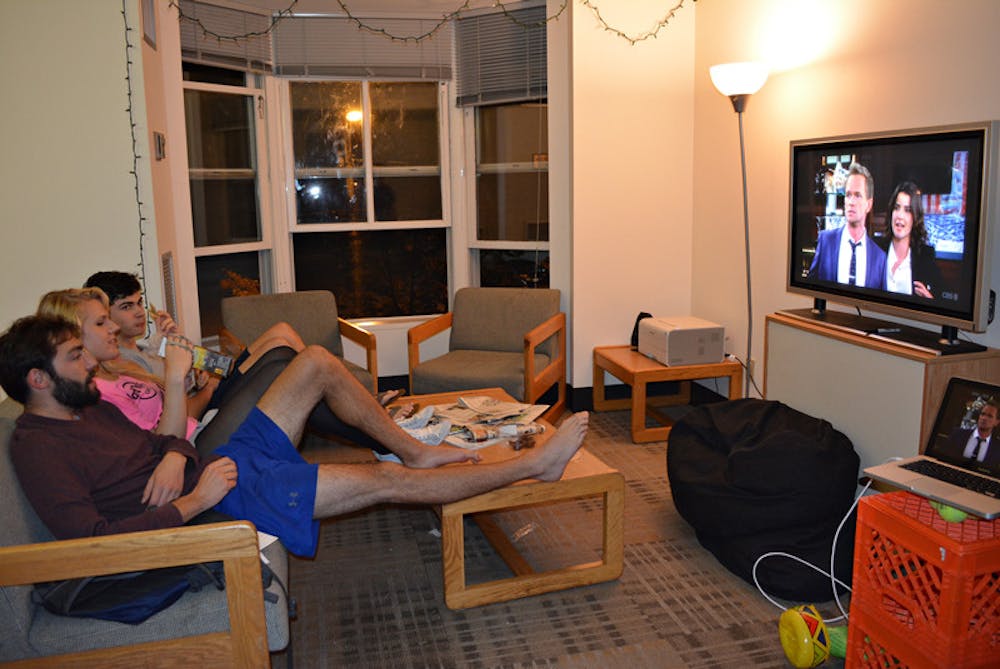The red glow of Netflix is a familiar greeting to procrastinators seeking refuge in the warm embrace of “30 Rock.”
Online content on demand with no commercial interruptions — this is the model of television consumption that has loomed large in public discourse about media over the last year. But the arrival of streaming services as both producers and purveyors of content is just one in a series of structural changes in the industry. There are more platforms for generating and viewing TV than ever before, and the stories the programs are telling meet new standards of production value and narrative complexity. Cue the critical claim that TV has entered a golden age: As students, faculty members and alums interested in film and television navigate a shifting media landscape, TV has become an attractive option for telling intersecting, longform narratives in a commercially viable package.
TV and the Academy
The critical study of television in its own right — instead of as an offshoot of film or cultural studies — is a fairly recent phenomenon in university settings, said Associate Professor of Modern Culture and Media Lynne Joyrich, who will teach an introductory course in television studies this spring.
“When I first started doing TV studies, it was seen as sort of silly,” she said. “Now I think it is more respected as a medium and as a form of study, as something important to study in academia.”
Television not only orders routines and broadcasts information, but it also structures the way pepole, through narrative formations, process everyday experience, Joyrich said.
“The same reason that people think it’s funny to study television is because it seems like studying the air we breathe,” she added. “But in the same way that in fact we do study the air we breathe, it’s important to study TV.”
Many students were introduced to the academic study of television last semester with the course COLT 1440A: “Storytelling in The Wire” taught by Assistant Professor of Comparative Literature Peter Saval. The class studied the program’s innovative engagement with contemporary social problems, the urban environment and narrative form, The Herald previously reported.
“TV is kind of where it’s at right now,” said Henry Chaisson ’15, a director of Brown Motion Pictures and Herald video editor, who took the class. “It can tell more complex stories than you could ever tell in a single film.”
Evaluating the ‘Golden Age’
Much of the critical attention surrounding the announcement of a “golden age” in television has focused on cinematic dramas. “The Sopranos,” “Mad Men” and, especially as of late, “Breaking Bad,” a triumvirate of high-production-value series, follow morally ambiguous male protagonists as they navigate a series of complex, intersecting narratives.
The growing prestige of this particular kind of series has altered professional outlooks among alums interested in breaking into the industry.
“Being a regular on a critically acclaimed TV show is kind of the dream job at this point,” said Madeleine Heil ’13, who is currently pursuing a career in acting in Los Angeles.
Nonetheless, assigning value to a certain category of television programs can be problematic.
“We also want to think about what sort of gender, race, class dynamics are at play in labeling something quality or as part of the golden age,” said Hunter Hargraves GS, a PhD candidate in the Department of Modern Culture and Media. “‘Breaking Bad,’ ‘The Sopranos,’ ‘Mad Men,’ ‘The Wire’ — they are by and large programs that take a very masculinist posture.”
Furthermore, the techniques for which many of the great millennial dramas are celebrated, such as interwoven storylines and complex characters, were not invented for the HBO toolkit.
“When people (say) ‘The Sopranos’ or ‘The Wire,’ ‘Mad Men,’ it’s so great unlike that trash on TV,” Joyrich said. “Well I’ll say actually they’re soap operas … which for me is not a bad word. For me, it describes a form of ongoing, intersecting, multiple narrative form.”
Distribution and consumption
The Internet, video sharing and crowd-sourced funding have democratized creative forays into TV production and filmmaking, students and community members said.
“Just go and make a movie with your family and friends,” said Maggie Hire ’15, one of the industry coordinators of the Ivy Film Festival. “Put it up online. Get funding through Indiegogo, or whatever you want to do for it. If you have the idea then I think it’s really obtainable.”
Online interaction and social media also affords viewers more power to influence a show’s reception.
“The way that people share things with each other is having a huge impact on which television shows are dispersed and made popular,” said Michael Chiboucas ’13.5, who is also pursuing a career in screen acting.
“In today’s convergence culture … I would say (the Internet) has actually lead to the growth of TV,” Joyrich said. “If anything with multimedia, I think TV is getting bigger and bigger.”
New viewing platforms also encourage previously unseen habits of consumption, such as “binge-consumption,” in which viewers can watch an entire series in a weekend.
“The whole idea of television is that … you can stream horizontally and go through a program’s commercial breaks, but also vertically and flip through channels and get breakage that way,” Hire said. “So by doing something like Netflix, you’re essentially eliminating both of those breaks.”
TV and film fluidity
The perceived superiority of film as an art form — the belief that “television has always been the sort of bad object of popular culture,” as Hargraves put it — might be eroding.
“Television has always been the pathway into film,” Chiasson said. “It’s not quite inverting, but it’s evening out.”
The much-talked-about example of Lena Dunham, whose film “Tiny Furniture” was influential in securing her HBO contract for the popular TV series “Girls,” points to this changing paradigm, Hire said.
Aesthetic gestures traditionally associated with the cinema, such as filming on multiple set locations, expensive cinematography and high definition video quality, are increasingly cropping up in network, cable and streaming television, Chaisson said. Some players, like director David Fincher, who won an Emmy for his involvement with the Netflix original series “House of Cards,” seem to be thriving across both media.
“TV’s just kind of becoming much more cinematic, much more film-like. They’re just putting a lot more money into it,” Heil said.
It is difficult to locate precisely where TV stands on campus and in the culture at large, but it seems to be changing and changing fast.
“You can’t make any simple pronouncements about television,” Joyrich said. “It’s good! It’s bad! It’s the downfall of our culture! No, it’s like the common media language that brings us together! It’s not one or the other. It’s in a complex relation between and across all those things.”

ADVERTISEMENT




